
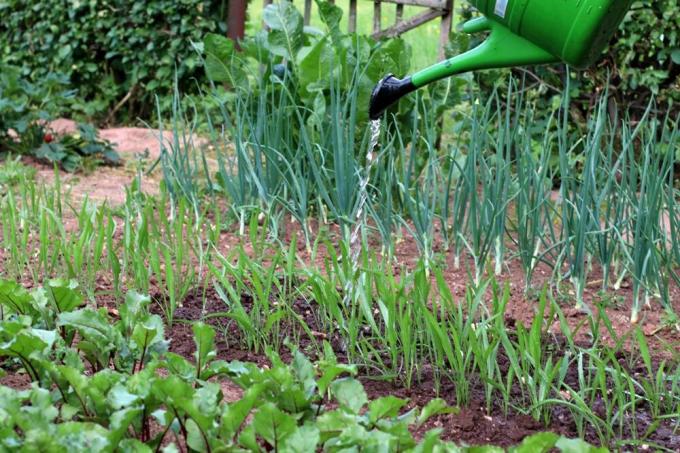
Table of contents
- requirements
- planning
- create beds
- Create space for compost
- shed
- First steps
Again and again one reads that vegetables from the supermarket are contaminated with pesticides or other pollutants. So it's not surprising that some people think about growing their own vegetables to be on the safe side. In order for this to be really worthwhile and to bring a reasonable yield, you absolutely need your own garden. In fact, interest in gardening yourself and becoming a small-scale vegetable farmer has increased significantly in recent years. With a little know-how, it's not that difficult.
requirements
The dream of your own vegetable garden is one thing, realizing it is something completely different. First of all, you need land for this. Although some types of vegetables can also be grown on the balcony, the yield there is usually limited. In no case is the balcony garden sufficient to provide for an entire family. So space is required. Anyone who owns their own house is usually fine. There is usually always some free space for a few beds on the property belonging to the house. On the other hand, if you are not a homeowner, you need alternatives. You can find them, for example, in an allotment garden or an alternative garden cooperative, in which you can lease a plot. However, the demand is very high, which is why it is often not possible without a certain waiting time. Maybe you can find a suitable small plot of land elsewhere that you can use for a garden. No matter how you get the necessary space, it should definitely meet the following requirements:
- Minimum size of 50 square meters, 100 square meters is better
- soil free of toxins and pollutants
- good accessibility also with a vehicle with a trailer, for example to deliver compost
- If possible, a sunny location, under no circumstances should the area be in permanent shade
- own water supply on the property
The last two points are particularly important. Vegetables need light and water to thrive. A garden in the shade of a large apartment building therefore makes just as little sense as one without a water connection. Above all, the water problem should not be underestimated - regardless of whether the garden is behind your own house or on a leased property. If you have to lug heavy watering cans from the basement into the garden several times a day during a hot summer, you will quickly appreciate a direct water connection.
planning
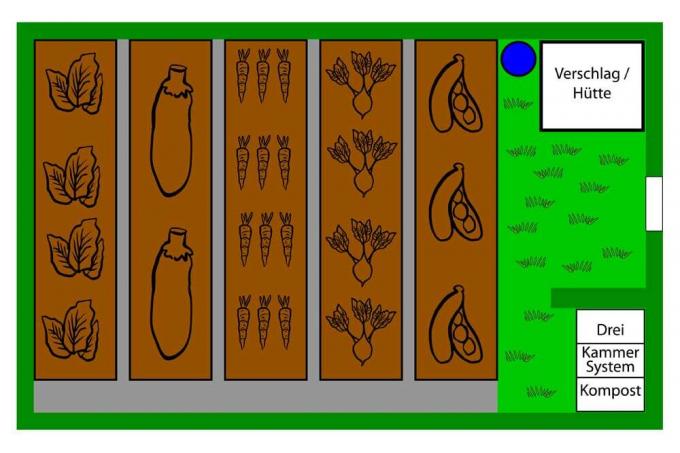
Once a suitable area has been found, the planning of the garden begins. Vegetables are best grown outdoors in beds. Although you could, at least theoretically, simply stick the seeds into the ground on the property, the harvesting success is then limited. Beds are therefore not only a quirk of order fanatics, but also guarantee sensible growth of the plants and, above all, make the indispensable gardening work easier. Without beds, a vegetable garden is therefore hardly conceivable. In addition, one should of course also choose a location for the available area Composting of garden waste and also a small hut or at least a shed for Plan garden tools.
The beds must always be laid out in the sunniest spot on the property. Of course, their number depends on how many types of vegetables you want to grow and what yield is important to you. Ultimately, of course, it also depends on how much space is available. An ideal bed is about five to six square meters. Incidentally, the length of the individual beds plays a subordinate role. Their width, on the other hand, should not exceed 1.20 meters in order to be able to reach the plants in the middle of the bed from the sides. The beds are each flanked by small paths that ensure access without having to climb directly into the bed.
Tip:
It is better to plan the entire vegetable garden and especially the beds a little smaller at the beginning. A garden is a lot of fun, but also a lot of work - ten square meters of vegetable beds require around 30 minutes of care per week.
Before you start realizing the garden, it is best to make a small plan on which the locations of the beds, the composting facility and the shed are drawn. The required paths and, if necessary, a windbreak for the beds should not be forgotten.
create beds
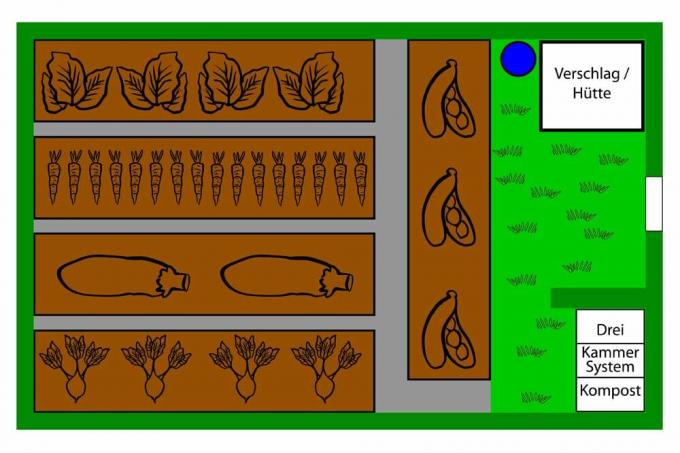
The number of beds depends crucially on two factors - the available area and the amount of vegetables that you want to grow. In order to be able to provide a family of four with enough vegetables over the summer, you need a bed area of around 150 square meters in total. As a rule, you will and have to get by with significantly less. Irrespective of this, the following area information should be taken into account when planting the beds.
- around six square meters (1.20 by five meters) per bed
- one square meter (0.20 by five meters) per path between the beds
- a minimum width of 50 centimeters for an access path at the head of the beds
Before you start creating the individual beds, the entire area should be dug up to the depth of a spade. If the soil is particularly heavily interspersed with clay, thorough digging up to a depth of two spade lengths is recommended. Roots and weeds that emerge must be carefully removed. A very loamy soil has only a very low permeability. In order to avoid waterlogging and to make it easier for the plants to root, the permeability should therefore be increased by mixing coarse sand into the soil.
It should be a layer of sand about ten centimeters high. It is best to first apply it to the surface in one piece and then mix it in with a rake or a cultivator. Finally, humus is applied. Garden compost is ideal for sandy soils. Rather loamy soils get leaf humus. Once this has been done, the beds can be staked out according to the dimensions and the earth can be trampled on the planned paths.
Create space for compost
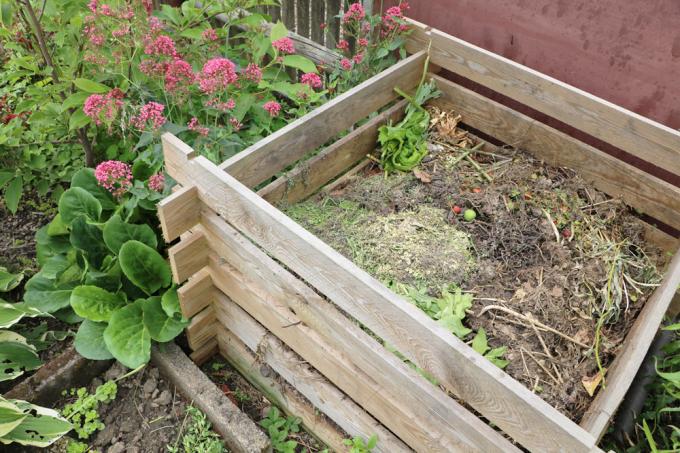
Compost is a natural fertilizer for plants that provides important nutrients. Over the course of a year, there is a lot of vegetable garden waste such as leaves, stalks, roots or grass, which can be turned into compost. It is therefore essential for every garden to have its own composting area - also because the garden waste can be disposed of in a completely natural way. A composter required for this is quickly built by yourself. For a system with the recommended three-chamber system you need:
- four wooden poles that form the corners of the structure
- four panels made of wood, plastic or metal as side panels
- two panels made of wood, plastic or metal to divide the interior
The place where the composter will stand must not be sealed. This makes it possible for worms and other animals to get to the garden waste from below and thus contribute to its decomposition. In addition, liquid released during composting can run off easily in this way. The three compartments of the composter each represent a different composting status. Fresh garden waste goes into the first chamber. If these have roughly decomposed, they are transferred to the second chamber. This frees up space for new waste. The finished compost can then be removed from the third chamber and used to fertilize the plants.
shed
Gardening can hardly be done without the appropriate tools and equipment such as a spade, shovel, rake or secateurs. It is advisable to store this equipment directly in the garden. On the one hand, you always have everything you need at hand. On the other hand, you save yourself the often tedious transport there and back. A small hut or at least a lockable shed is suitable as a storage location. Garden sheds made of wood or metal can be purchased as a kit from garden retailers. There are also crates to buy there. A shed can also be built relatively easily from boards and wooden planks.
First steps
Once the future vegetable garden has been laid out, it is time to equip it with plants. In principle, of course, all types of vegetables that grow under our climatic conditions are suitable for this - regardless of whether you prefer to sow seeds or plant young plants in the ground. For starters, however, we recommend those types of vegetables that grow relatively quickly. These include, among others:
- all salads
- Kohlrabi
- carrots
- radish
- beans
- Peas
- zucchini
These varieties not only have the advantage that young gardeners can see success very quickly - they are also relatively frugal and easy to care for. On the other hand, if you are less interested in speed and have a little more patience, you should think about only growing potatoes in all beds first. The coarse tubers have the inestimable advantage that they loosen the soil permanently. In addition, their lush foliage prevents weeds from spreading on the surface. Potatoes are something like the ideal start for the fresh beets. They condition the beds for later, so to speak, and at the same time provide plenty of garden waste that is wonderfully compostable. And honestly, who can claim to eat potatoes from their own garden?
 garden editorial
garden editorial I write about everything that interests me in my garden.
Learn more about creating a vegetable garden
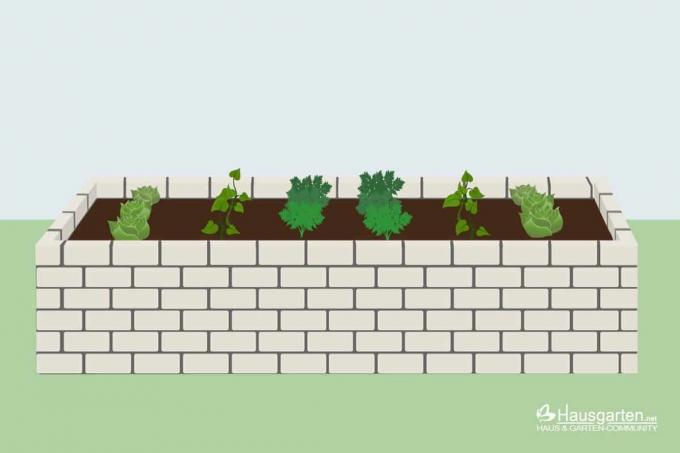
Build your own raised bed out of stones: this is how it works
Building a raised bed out of stones is more complex than variants made out of wood or aerated concrete. On the other hand, they are very durable, decorative, offer decisive advantages and can even increase yields. We explain how it works here.

18 good neighbors of broccoli | mixed culture
Broccoli is a close relative of cauliflower and a great homegrown vegetable. In the vegetable garden, it is generally advisable to pay attention to good plant neighbors. A corresponding mixed culture has many advantages for all species involved.

Paths in the vegetable garden: 7 ideas for beautiful and practical bed paths
As a rule, there is no way in the vegetable garden without paths. Only through them can all beds be easily reached. Of course you have to think about how to create and design them. Here are some tips and ideas.

Planning a vegetable garden - my first small self-sufficient garden
The vegetable garden is an important first step on the way to independent self-sufficiency. In order for your self-sufficient life to get off to a good start, it depends on the right planning, from A, for cultivation area, to Z, for fence. This step-by-step guide explains how to make your first small self-sufficient garden perfect.

Choose the right film for the raised bed
Raised beds are not only a big trend, they can make growing fresh vegetables and aromatic herbs a lot easier. With a flexible choice of location, the design options are almost inexhaustible. Raised beds can be made of different materials that suffer to varying degrees from soil moisture. This requires good protection.
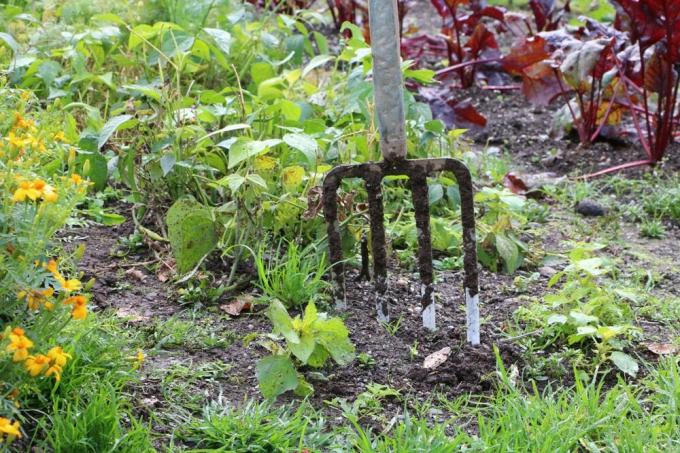
Creating an organic garden - tips on plants, varieties and crop rotation
Pesticide-free and sustainable: There are many reasons for cultivating an organic garden. The near-natural landscapes also offer a protected retreat for endangered plant species. Creating an organic garden is easy to do. With the right preparation, it is possible to enjoy a bountiful bloom and harvest in the summer.

